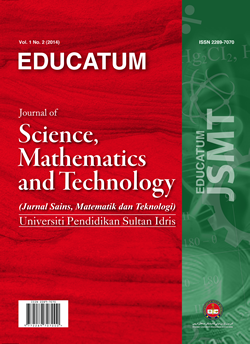A study on the use of collaborative learning to enhance mathematical understanding among elementary students
DOI:
https://doi.org/10.37134/ejsmt.vol9.2.2.2022Keywords:
collaborative learning, mathematical communication, mathematical understanding, elementaryAbstract
This study investigated the use of collaborative learning to enhance mathematical understanding among elementary students. This study will give an overview on the usage of collaborative learning in mathematical teaching and learning as an interactive and interesting alternative approach that helps in enhancing mathematical understanding of learners. Mathematics may be regards as hard and difficult subject by most learners as they tend to be learning this subject in more traditional approach. This study focuses on the objective to study the interactions of the students during the collaborative learning activities, to investigate students’ perception and attitude towards collaborative learning as well as the effectiveness of collaborative learning in enhancing student’s mathematical understanding. This study employed the qualitative approach by combining the Communication Study Framework by Sfard and Kieren (2001) and The Pirie-Kieren Theory (1992,1991). The data collected from selective respondents were analysed through the recorded videos of the mathematics lessons on selected sub-topic. From the data, the respondents indicated active interactions during the tasks, and it also indicated that by having collaborative learning, respondents have positive perceptions and attitudes based on their active participations during the group discussions. From the data as well, the respondents’ portrayed appropriate level of mathematical understanding based on the selected topic.
Downloads
References
Dekker, R., Elshout-Mohr, M., & Wood, T. (2006). How children regulate their own collaborative learning. Educational Studies in Mathematics, 62(1), 57-79.
Duraman, H. S. A. H., Shahrill, M., & Morsidi, N. M. H. (2015). Investigating the effectiveness of collaborative learning in using the snowballing effect technique. Asian Journal of Social Sciences & Humanities, 4(1), 148-155.
Farokhah, L., Nurmulia, F., Herman, T., Jupri, A., Pratiwi, V., Nurkaeti, N., & Abidin, Z. (2021, March). The improvement of mathematical communication ability of elementary school students through project-based learning using mind map technique. In Journal of Physics: Conference Series (Vol. 1806, No. 1, p. 012105). IOP Publishing.
Jaisook, S., Chitmongkol, S., & Thongthew, S. (2013). A mathematics instructional model by integrating problem-based learning and collaborative learning approaches. Humanities, Arts and Social Sciences Studies (Former Name Silpakorn University Journal Of Social Sciences, Humanities, And Arts), 271-294.
Laal, M., & Ghodsi, S. M. (2012). Benefits of collaborative learning. Procedia-social and behavioral sciences, 31, 486-490.
Maelasari, E. (2017, September). Effects of Cooperative Learning STAD on Mathematical Communication Ability of Elementary School Student. In Journal of Physics: Conference Series (Vol. 895, No. 1, p. 012090). IOP Publishing.
Moreno-Guerrero, A. J., Rondon Garcia, M., Martinez Heredia, N., & Rodríguez-García, A. M. (2020). Collaborative learning based on harry potter for learning geometric figures in the subject of mathematics. Mathematics, 8(3), 369.
Nik Azis, N. P. (2003). Isu-isu kritikal dalam pendidikan matematik. Kuala Lumpur: Penerbit Universiti Malaya.
Sam, H. K., & George Tan, G. S. (2011). The Effectiveness of Collaborative Learning In The Teaching of Form Four Mathematical Reasoning. Jurnal Teknologi, 55(1), 55–73. https://doi.org/10.11113/jt.v55.81
Swan, M. (2006). Collaborative learning in mathematics. A Challenge to our Beliefs, 162-176.
Suwangsih, E., Budiarti, M. R., Ruskandi, K., Hendawati, Y., & Majid, N. W. A. (2019, October). Two-stay two-stray model on improving mathematical communication skill of elementary school students. In Journal of Physics: Conference Series (Vol. 1318, No. 1, p. 012127). IOP Publishing.
Downloads
Published
How to Cite
Issue
Section
License
Copyright (c) 2022 Noor Aida Affida Abdul Rahman, Mohd Faizal Nizam Lee Abdullah

This work is licensed under a Creative Commons Attribution-NonCommercial-ShareAlike 4.0 International License.





